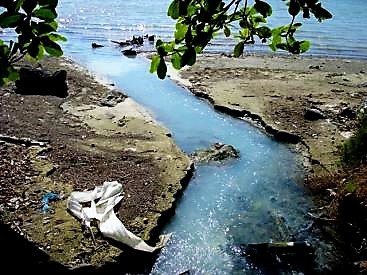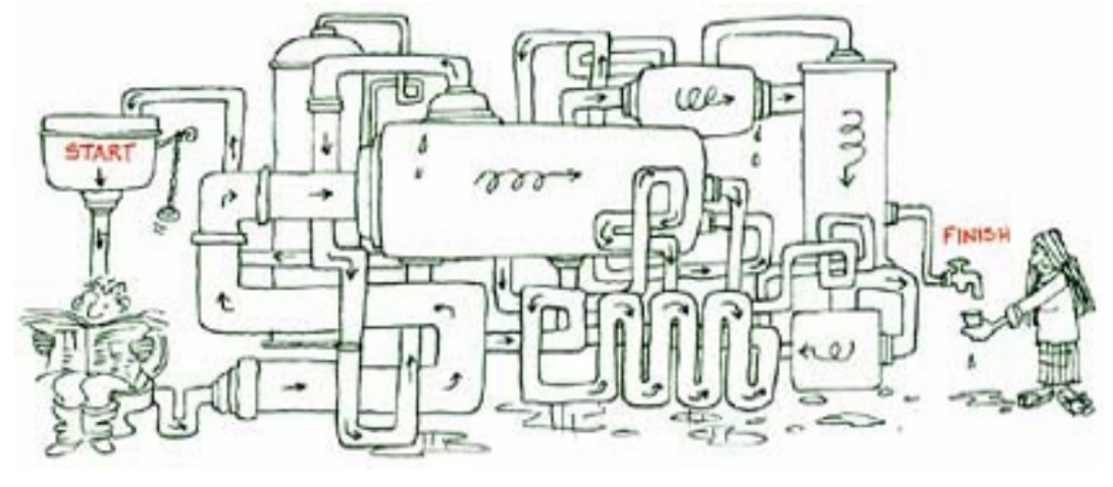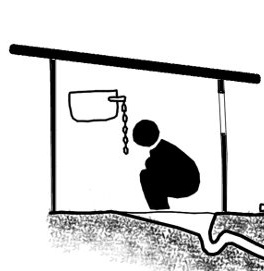Executive Summary
The cistern flush toilet is usually made of porcelain and is a mass-produced, factory-made user interface. The flush toilet consists of a water tank that supplies the water for flushing the excreta and a bowl into which the excreta are deposited.
Dual flush or water-saving toilets are available to reduce flush water. A siphon provides a water seal against odours from the effluent pipe. Cistern-flush toilets provide a high level of convenience for the user but they use large amounts of water. Installing this toilet system results in significantly increased water consumption by the users and the generation of large amounts of wastewater. In many cases, the “flush and forget” mentality is the source of water pollution.
| In | Out |
|---|---|
Freshwater, Urine or Yellowwater, Faeces, Excreta, Dry Cleansing Materials, Aanal Cleansing Water |
Blackwater |
The attractive feature of the cistern flush toilet is that it incorporates a sophisticated water seal to prevent odours from coming back up through the plumbing. Water that is stored in the cistern above the toilet bowl is released by pushing or pulling a lever. This allows the water to run into the bowl, mix with the excreta, and carry them away.
Design considerations
Modern toilets use 6 to 9 L per flush, whereas older models were designed for flushwater quantities of up to 20 L. There are different low-volume flush toilets currently available that can be used with as little as 3 L of water per flush. In some cases, the volume of water used per flush is not sufficient to empty the bowl and, consequently, the user has to flush two or more times to adequately clean the bowl, which negates the intended saving of water.
A good plumber is required to install a flush toilet. The plumber will ensure that all valves are connected and sealed properly, therefore, minimizing leakage. To correctly connect the toilets, a collection system such as a septic tank or sewer network needs to be provided (see also wastewater collection). The collection system on its turn has to be connected to an appropriate treatment system.
<> To safe water, there are dual flush toilets available, with two different flush volumes to reduce water use (UNEP 2002). There are also flush toilets on the market that collect the urine separately and use a very low flush volume to flush the urine away (UNESCO-IHE 2009).

Health aspects/acceptance
It is a safe and comfortable toilet to use provided it is kept clean. But in many cases, toilet wastewater flows through a sewer system directly into the environment without any treatment. This spreads pathogens and can endanger the health of residents (see also module 5: health and hygiene issues and pathogens and contaminants).
Operation & maintenance
Although flushwater continuously rinses the bowl, the toilet should be scrubbed clean regularly to maintain hygiene and prevent the buildup of stains. Maintenance is required for the replacement or repair of some mechanical parts or fittings. Menstrual hygiene products should be collected in a separate bin (see also menstrual hygiene management).
[no-ecompendium] Cost considerations
A flush toilet can cost anywhere from $20 to $200. Depending on the location and type of toilet, water can become a significant operational cost factor (EAWAG/SANDEC 2008).
Ecologically mindless
Even though the flush toilet is a very comfortable toilet system, it is ecologically mindless. Besides the fact that huge amounts of freshwater are polluted by faeces, in many countries there is no treatment plant at the end of a sewerage system. Consequently, all kinds of wastewaters flow directly in rivers, lakes, the sea or infiltrate into the groundwater and contaminate these water sources (see also water pollution).

Sunita Narain describes cistern flush toilets and sewerage systems in an article (NARAIN 2002) as a part of the environmental problem and not as a solution: “Consider the large amount of clean water that is used to carry even a small quantity of human excreta. In India, flushes are designed to be particularly water-wasteful. So with each flush, over 10 litres of clean water goes down the drain. We build huge dams and irrigation systems to bring water to urban areas. This water which is flushed down the toilet goes into an equally expensive sewage system, all to end up polluting more water — invariably our rivers and ponds. Most of our rivers are today dead because of the domestic sewage load from cities. We have turned our surface water systems into open sewage drains” (NARAIN 2002).

Nowadays, many other and more sustainable and ecological toilet systems are available. Learn more: vacuum toilet, urine diversion flush toilet, UDDT, composting toilet, terra preta toilet, fossa alterna and arborloo.
[no-ecompendium] At a glance
| Working principle | Water that is stored in the cistern above the toilet bowl is released by pushing or pulling a lever and used to flow away the human wastes. |
| Capacity/adequacy | Basically it can be built everywhere, urban and rural areas. A constant source of water must be available. |
| Performance | High performance if installed correctly. |
| Costs | A flush toilet can cost anywhere from $20−200. Depending on the location and type of toilet, water can become a significant operational cost factor (EAWAG/SANDEC 2008). |
| It might be hard to find spare parts. Because of the complexity of the flush mechanism, it is difficult to do reparations. | |
| Easy to use and clean. | |
| If well maintained and constructed, and if water available, high. | |
| Comfortable and hygienic for the user. | |
| Generates a large volume of sewage to be discharged and pollutes big amounts of fresh water. |
A flush toilet should not be considered unless all of the water distribution and sewer connections (e.g. conventional sewers, separate sewers, simplified sewers or vacuum sewers and hardware accessories are available locally. The cistern flush toilet must be connected to both a constant source of water (can be a big problem and controversy in arid climates) for flushing and a collection and storage/treatment or conveyance technology to receive the blackwater. The flush toilet is suitable for both public and private applications and can be used in every climate (TILLEY et al. 2008).
Sanitation Systems and Technologies. Lecture Notes
Lecture notes on technical and non-technical aspects of sanitation systems in developing countries.
EAWAG/SANDEC (2008): Sanitation Systems and Technologies. Lecture Notes . (= Sandec Training Tool 1.0, Module 4 ). Duebendorf: Swiss Federal Institute of Aquatic Science (EAWAG), Department of Water and Sanitation in Developing Countries (SANDEC)Assembling and Installing a New Toilet
Describes how to install a toilet with full color photos and step-by-step instructions.
MAKI, B. (2005): Assembling and Installing a New Toilet. Hammerzone.com URL [Accessed: 25.08.2014]The Flush Toilet is Ecologically Mindless
Critical article by environmental activist and Stockholm Water Price Laureate Sunita Narain, on why it is mindless to waste so much clean water to flush away excreta.
NARAIN, S. (2002): The Flush Toilet is Ecologically Mindless. In: Down to Earth: Volume 19 URL [Accessed: 12.05.2019]Compendium of Sanitation Systems and Technologies. 2nd Revised Edition
This compendium gives a systematic overview on different sanitation systems and technologies and describes a wide range of available low-cost sanitation technologies.
TILLEY, E., ULRICH L., LÜTHI, C., REYMOND P. and ZURBRÜGG C. (2014): Compendium of Sanitation Systems and Technologies. 2nd Revised Edition. Duebendorf, Switzerland: Swiss Federal Institute of Aquatic Science and Technology (Eawag) URL [Accessed: 03.05.2023] PDFCompendium of Technologies
Toilets: Installation and Repair
Describes each part of the toilet in detail and provides links to other tools, such as how to install a toilet, how to fix a leaking toilet and other toilet essentials.
VANDERVORT, D. (2007): Toilets: Installation and Repair. HomeTips.com URL [Accessed: 25.08.2014]Compendium of Sanitation Systems and Technologies (Arabic)
This is the Arabic version of the Compendium of Sanitation Systems and Technologies. The Compendium gives a systematic overview on different sanitation systems and technologies and describes a wide range of available low-cost sanitation technologies.
TILLEY, E. ULRICH, L. LUETHI, C. REYMOND, P. SCHERTENLEIB, R. ZURBRUEGG, C. (2014): Compendium of Sanitation Systems and Technologies (Arabic). 2nd Revised Edition. Duebendorf, Switzerland: Swiss Federal Institute of Aquatic Science and Technology (Eawag) PDFSick Water? The central role of wastewater management in sustainable development
This book not only identifies the threats to human and ecological health that water pollution has and highlights the consequences of inaction, but also presents opportunities, where appropriate policy and management responses over the short and longer term can trigger employment, support livelihoods, boost public and ecosystem health and contribute to more intelligent water management.
CORCORAN, E. ; NELLEMANN, C. ; BAKER, E. ; BOS, R. ; OSBORN, D. ; SAVELLI, H. (2010): Sick Water? The central role of wastewater management in sustainable development. A Rapid Response Assessment. United Nations Environment Programme (UNEP), UN-HABITAT, GRID-Arendal URL [Accessed: 05.05.2010] PDFSanitation Systems and Technologies. Lecture Notes
Lecture notes on technical and non-technical aspects of sanitation systems in developing countries.
EAWAG/SANDEC (2008): Sanitation Systems and Technologies. Lecture Notes . (= Sandec Training Tool 1.0, Module 4 ). Duebendorf: Swiss Federal Institute of Aquatic Science (EAWAG), Department of Water and Sanitation in Developing Countries (SANDEC)Closing the loop – Ecological Sanitation for food security
This document was compiled during an international, interdisciplinary workshop in Mexico. This manuscript increases the understanding of how to develop more sustainable sanitation systems, particularly in urban/peri-urban contexts, while contributing to food production and improved nutrition.
ESREY, S.A. ANDERSSON, I. HILLERS, A. SAWYER, R. (2001): Closing the loop – Ecological Sanitation for food security. Stockholm: Swedish International Development Cooperation Agency URL [Accessed: 24.11.2010]The Flush Toilet is Ecologically Mindless
Critical article by environmental activist and Stockholm Water Price Laureate Sunita Narain, on why it is mindless to waste so much clean water to flush away excreta.
NARAIN, S. (2002): The Flush Toilet is Ecologically Mindless. In: Down to Earth: Volume 19 URL [Accessed: 12.05.2019]Ecological Sanitation A Way to Solve Global Sanitation Problems
The paper presents an introduction to ecological sanitation (ecosan) principles and concepts including re-use aspects (available nutrients and occurring risks), and case studies of ecosan concepts in both industrialised and developing countries.
LANGERGRABER, G. MUELLEGGER, E. (2004): Ecological Sanitation A Way to Solve Global Sanitation Problems. Vienna: University of Natural Resources and Applied Life Sciences URL [Accessed: 14.03.2011]Compendium of Sanitation Systems and Technologies. 2nd Revised Edition
This compendium gives a systematic overview on different sanitation systems and technologies and describes a wide range of available low-cost sanitation technologies.
TILLEY, E., ULRICH L., LÜTHI, C., REYMOND P. and ZURBRÜGG C. (2014): Compendium of Sanitation Systems and Technologies. 2nd Revised Edition. Duebendorf, Switzerland: Swiss Federal Institute of Aquatic Science and Technology (Eawag) URL [Accessed: 03.05.2023] PDFA Directory of Environmentally Sound Technologies for the Integrated Management of Solid, Liquid and Hazardous Waste for Small Island Developing States (SIDS) in the Pacific Region
This directory is part of UNEP collaboration with SIDS on the implementation of the Waste Management chapter of the Barbados Programme of Action. It focuses primarily on proven sound environmental technologies for solid, liquid and hazardous waste management plus those currently successfully being used in SIDS within the Pacific Region.
UNEP (2002): A Directory of Environmentally Sound Technologies for the Integrated Management of Solid, Liquid and Hazardous Waste for Small Island Developing States (SIDS) in the Pacific Region. The Hague: United Nations Environment Programme (UNEP) URL [Accessed: 28.03.2012]Construction of Ecological Sanitation Latrine
This document sets out the principles for adopting an ecological sanitation approach, as well as providing guidance on the construction ecological sanitation latrines and their operation. It is intended to support sanitation field practitioners and WaterAid in Nepal ’s partners in the delivery of appropriate services and technologies to fit the needs of different users. .It is also equally hoped that this document will be of value to other organisations and sector stakeholders involved in sanitation promotion and ecological sanitation.
WATER AID (2011): Construction of Ecological Sanitation Latrine. Kathmandu: Water Aid URL [Accessed: 19.10.2011]How to Select Appropriate Technical Solutions for Sanitation
The purpose of this guide is to assist local contracting authorities and their partners in identifying those sanitation technologies best suited to the different contexts that exist within their town. The first part of the guide contains a planning process and a set of criteria to be completed; these assist you in characterizing each area of intervention so that you are then in a position to identify the most appropriate technical solutions. The second part of the guide consists of technical factsheets which give a practical overview of the technical and economic characteristics, the operating principle and the pros and cons of the 29 sanitation technology options most commonly used in sub-Saharan Africa.
MONVOIS, J. GABERT, J. FRENOUX, C. GUILLAUME, M. (2010): How to Select Appropriate Technical Solutions for Sanitation. (= Six Methodological Guides for a Water and Sanitation Services' Development Strategy , 4 ). Cotonou and Paris: Partenariat pour le Développement Municipal (PDM) and Programme Solidarité Eau (pS-Eau) URL [Accessed: 19.10.2011]How to Manage Public Toilets and Showers
The purpose of this decision-making aid is to provide practical advice and recommendations for managing toilet blocks situated in public places. It is primarily aimed at local decision-makers in developing countries and at their partners (project planners and managers).
TOUBKISS, J. (2010): How to Manage Public Toilets and Showers. (= Six Methodological Guides for a Water and Sanitation Services' Development Strategy , 5 ). Cotonou and Paris: Partenariat pour le Développement Municipal (PDM) and Programme Solidarité Eau (pS-Eau) URL [Accessed: 19.10.2011]Mix or NoMix - A Closer Look at Urine Source Separation
Beside the headarticle about 'Novaquatis', an inter- and transdisciplinary Eawag project, investigated urine source separation and treatment as an option for modern wastewater management, there are more article about urine sepeartion and its development.
EAWAG (2007): Mix or NoMix - A Closer Look at Urine Source Separation. (= Eawag News , 63 ). Duebendorf: Swiss Federal Institute of Aquatic Science and Technology (EAWAG) URL [Accessed: 06.02.2012]Novaquatis final report. NoMix – A new approach to urban water management
From 2000 to 2006, the cross-cutting project Novaquatis explored the potential of urine source separation – also known as NoMix technology. Novaquatis comprises nine work packages, largely organized around the various stages of a nutrient cycle (e.g. user acceptation, sanitary technologies, storage and transport, urine treatment and fertiliser production, micropollutants in urine, urine-based fertilisers). The final report contains the results of all working packages as well as a practical guide for interested NoMix user.
LARSEN, T. A. LIENERT, J. (2007): Novaquatis final report. NoMix – A new approach to urban water management. Duebendorf: Swiss Federal Institute for Environmental Science (EAWAG) URL [Accessed: 12.05.2019]Available Sanitation Technologies for Rural and Peri-Urban Africa
The presentation allows for a good overview on existing types of pit latrines in Africa, but also on other types of sanitation technologies such as the conventional flush toilet, the pour flush toilet, and the urine diversion dehydration toilet (UDDT).
MORGAN, P. (2007): Available Sanitation Technologies for Rural and Peri-Urban Africa. Stockholm : Ecological Sanitation Research (EcoSanRes), Stockholm Environment Institute (SEI) URL [Accessed: 20.06.2013]http://www.hammerzone.com/
This page describes how to install a toilet with full colour photos and step-by-step instructions.
http://www.hometips.com/
This page describes each part of the toilet in detail and provides links to other tools, such as how to install a toilet, how to fix a leaking toilet and other toilet essentials.
A Better Toilet For A Cleaner World
The sanitation technology paradigm is under review, as past approaches are not sufficient or affordable to close the sanitation coverage gap. In 2011, the Bill & Melinda Gates Foundation (BMGF) launched the bold Reinvent the Toilet Challenge (RTTC) program to promote the development of radically new innovations to address the sanitation challenge on a large-scale. The RTTC is premised on the fact that ground-breaking improvements are required in toilet design and fecal sludge management to close the urban sanitation gap. The RTTC is focused on reinventing the flush toilet, a break-through public health invention that has not changed substantially since the first flush toilet patent was issued in 1775.


